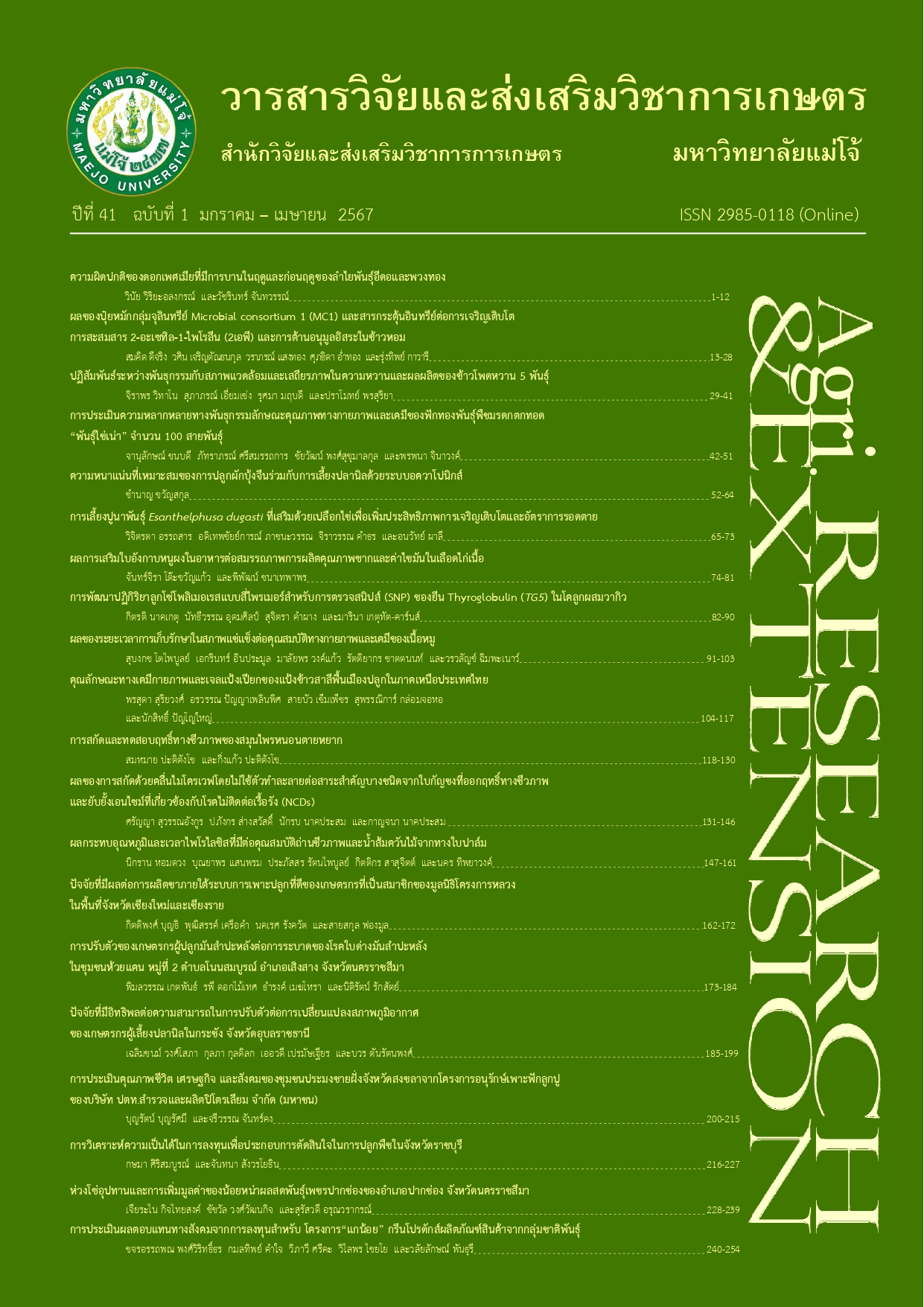การเลี้ยงปูนาพันธุ์ Esanthelphusa dugasti ที่เสริมด้วยเปลือกไข่ เพื่อเพิ่มประสิทธิภาพการเจริญเติบโตและอัตราการรอดตาย
DOI:
https://doi.org/10.14456/jare-mju.2024.6คำสำคัญ:
ปูนา, เปลือกไข่, การเจริญเติบโต, อัตราการรอดตายบทคัดย่อ
การศึกษาการเลี้ยงปูนา Esanthelphusa dugasti ที่เสริมด้วยผงเปลือกไข่เพื่อเพิ่มประสิทธิภาพการเจริญเติบโตและอัตราการรอดตาย โดยวางแผนการทดลองแบบสุ่มตลอด ประกอบด้วย 5 ชุดการทดลอง ๆ ละ 3 ซ้ำ คือ ชุดการทดลองที่ 1 อาหารที่ไม่มีการเสริมเปลือกไข่ (ชุดควบคุม) และชุดการทดลองที่ 2–5 อาหารเสริมด้วยเปลือกไข่ 3, 5, 7 และ 10 เปอร์เซ็นต์ ตามลำดับ โดยใช้ลูกปูนาอายุ 7 วัน หลังจากที่หลุดจากท้องแม่ มีน้ำหนักเริ่มต้นเฉลี่ย เท่ากับ 0.006 กรัม ความกว้างกระดองเริ่มต้นเฉลี่ย เท่ากับ 0.218±0.008 ซม. และความยาวกระดองเริ่มต้นเฉลี่ย เท่ากับ 0.178±0.011 ซม.ระยะเวลาการเลี้ยง 90 วัน พบว่าปูนาที่เลี้ยงด้วยอาหารเสริมเปลือกไข่ มีประสิทธิภาพการเจริญเติบโตดีกว่าชุดควบคุมที่ไม่มีการเสริมเปลือกไข่ในอาหาร โดยปูนาที่เลี้ยงด้วยอาหารเสริมเปลือกไข่ที่ปริมาณ 7 เปอร์เซ็นต์ มีประสิทธิภาพการเจริญเติบโตที่ดีกว่า ในด้านน้ำหนัก เพิ่มเฉลี่ย (WG) น้ำหนักเพิ่มเฉลี่ยต่อวัน (ADG) ความกว้างกระดองเพิ่มเฉลี่ย (CWG) และความยาวกระดองเพิ่ม เฉลี่ย (CLG) เท่ากับ 3.535±0.513 กรัม 0.039±0.006 กรัมต่อวัน 1.996±0.120 ซม. และ 1.640±0.092 ซม. ตามลำดับ รวมถึงอัตราการรอดตาย เท่ากับ 93.333±2.887 เปอร์เซ็นต์ ดังนั้นอาหารเสริมด้วยเปลือกไข่ที่ปริมาณ 7 เปอร์เซ็นต์ มีความเหมาะสมสำหรับการเลี้ยงปูนา และสามารถต่อยอดเพื่อการเพิ่มผลผลิตระบบการเลี้ยงปูนา
เอกสารอ้างอิง
AOAC. 2000. Official Methods of Analysis of AOAC International. 17th edition. Maryland: AOAC International. 2200 p.
Austreng, E. 1978. Digestibility determination in fish using chromic oxide marking and analysis of contents from different segments of the gastrointestinal tract. Aquaculture 13(3): 265-272.
Davis, D.A. 1990. Dietary Mineral Requirement of Penaeus monodon: Evaluation of the Essentiality for Thirteen Minerals and the Requirements for Calcium Phosphorus Copper, Iron, Zinc and Selenium. Doctoral Dissertation. Texas A&M University. 171 p.
Diesel, R. and M. Schuh. 1993. Maternal care in the bromeliad crab Metopaulias depressus (Decapoda): maintaining oxygen, pH and calcium levels optimal for the larvae. Behavioral Ecology and Sociobiology 32(1): 11-15.
Domrongpokkaphan, V. 2012. Eggshell utilization technology. The Journal of Applied Science 11(2): 75-83. [in Thai]
Doolgindachbaporn, S., P. Jaruratjamorn, S. Khongsai and T. Doolgindachbaporn. 2001. Studies on Age and Growth of Rice-field Crab, Esanthelphusa dugasti (Rathbun). pp. 260-265. In Proceedings of the 39th Kasetsart University Annual Conference: Fisheries, Agro-Industry. Bangkok: Kasetsart University. [in Thai]
Duangjinda, M. 2001. Using SAS Programs to Analyze Animal Research. 2 nd. Khon Kean: Klungnanawittaya Publisher. 324 p. [in Thai].
Fieber, L.A. and P.L. Lutz. 1985. Magnesium and calcium metabolism during molting in the freshwater prawn Macrobrachium rosenbergii. Canadian Journal of Zoology 63(5): 1120-1124.
Micheli, F., F. Gherardi and M. Vannini. 1990. Growth and reproduction in the freshwater crab, Potamon fluviatile (Decapoda, Brachyura). Freshwater Biology 23(3): 491-503.
Miyazaki, I. and D.E. Wykoff. 1965. On a new lung fluke Paragonimus siamensis n. sp. found in Thailand (Trematoda: Troglotrematidae). Japanese Journal of Parasitology 14(3): 251-257.
Naiyanetr, P. 1994. On three new genera of Thai rice–field crabs allied to Somanniathelphusa Bott, 1968 (Crustacean: Decapoda: Brachyura: Parathelphusidae). The Raffles Bulletin of Zoology 42(3): 695-700.
Ok, Y.S., S.S. Lee, W.T. Jeon, S.E. Oh, A.R. Usman and D.H. Moon. 2011. Application of eggshell waste for the immobilization of cadmium and lead in a contaminated soil. Environmental Geochemistry and Health 33(1): 31-39.
Pakdeenarong, N., P. Chantiratikul and A. Chantiratikul. 2009. Natural diet of the rice–field crab, Esanthelphusa dugasti Rathbun 1902, in rainy season. KKU Science Journal 37(1): 49-55. [in Thai]
Panalikul, P., S. Doolgindachbaporn and S. Wongmaneeprateep. 2017. Dietary premix levels calcium and phosphorus ratios on growth performance of juvennile rice–field crabs (Esanthelphusa dugasti). Thai Journal of Agricultural Science Society of Thailand 50(1): 36-48. [in Thai]
Pisamayarom, K. and S. Phadasri. 2020. The effects of calcium on the growth and molting of rice field crab. The Agricultural Science Journal 51(Suppl.1): 443-448. [in Thai]
Roer, R. and R. Dillaman. 1984. The structure and calcification of the crustacean cuticle. American Zoologist 24(4): 893-909.
Yaemput, S., P. Dekumyoy and K. Visiassuk. 1994. The natural first intermediate host of Paragonimus siamensis (Miyazaki and Wykoff, 1965) in Thailand. Southeast Asian Journal of Tropical Medicine and Public Health 25: 284-284.
Zanotto, F.P., F. Pinheiro, L.A. Brito and M.G. Wheatly. 2004. Some considerations on calcium homeostasis in semi–terrestrial crabs. International Congress Series 1275: 89-95.
ดาวน์โหลด
เผยแพร่แล้ว
รูปแบบการอ้างอิง
ฉบับ
ประเภทบทความ
สัญญาอนุญาต
ลิขสิทธิ์ (c) 2024 วารสารวิจัยและส่งเสริมวิชาการเกษตร

อนุญาตภายใต้เงื่อนไข Creative Commons Attribution-NonCommercial-NoDerivatives 4.0 International License.
บทความนี้ได้รับการเผยแพร่ภายใต้สัญญาอนุญาต Creative Commons Attribution-NonCommercial-NoDerivatives 4.0 International (CC BY-NC-ND 4.0) ซึ่งอนุญาตให้ผู้อื่นสามารถแชร์บทความได้โดยให้เครดิตผู้เขียนและห้ามนำไปใช้เพื่อการค้าหรือดัดแปลง หากต้องการใช้งานซ้ำในลักษณะอื่น ๆ หรือการเผยแพร่ซ้ำ จำเป็นต้องได้รับอนุญาตจากวารสาร





